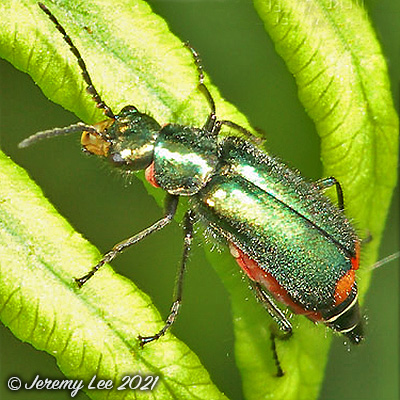
 |
|
Scientific Classifications explained » Amphibians » Ants » Aphids » Bees » Beetles » Birds » Bugs » Butterflies » Caterpillars » Damselflies » Dragonflies » Earwigs » Flies » Frog/Leafhoppers » Fungi » Galls » Grasshoppers » Harvestmen » Hoverflies » Lacewings » Ladybirds » Leaf Mines » Lichens » Mammals » Millipedes » Mosses » Moths » Sawflies » Slugs » Snails » Spiders » Trees » Wasps » Wild Flowers » Woodlice |
UK Nature > Beetles > Malachius bipustulatus

Scientific Name: Malachius bipustulatus Common Name: Malachite Beetle Malachius bipustulatus, or the Malachite Beetle, has a body length of 5–7 millimetres; the head and pronotum are brownish-green, while elytra are shining metallic green with a bright red spot at the end. Along the sides of the abdomen this species has a peculiar structure with orange patches. During the day they stay on herbs and flowers, including flowers of garden plants, mainly on Apiaceae, Asteraceae and Rosaceae species, where they feed on pollen, nectar and small insects. The males attract females producing special secretions from its antennae. Malachius bipustulatus is an insect with a complete metamorphism, or holometabolism, with four life stages (egg, larva, pupa and imago or adult). The pupal stage is a period of rest, when inner and outer bodies change. The larvae and the adults largely differ in physique and lifestyle. The larvae usually live under bark, in old wood or on the ground in grass roots, hunting small insects, larvae and slugs. |
|

https://www.uknature.co.uk is a website dedicated to showing the immense diversity of UK nature and wildlife. Our vast range of habitats, from lowland arable to snow covered mountains, from storm-ravaged coastlines to peaceful inland freshwater lakes and rivers, from dry, sandy heaths to deciduous and coniferous forests, all these habitats contribute to the abundance of UK nature. We have wild birds in huge numbers either residing or visiting our shores (597 recorded species as at July 2013) and we must also not forget the humble back garden with its grass lawns, flower beds filled with nectar rich flowers, shrubs and trees, all designed to attract huge numbers of insects such as bees, moths, butterflies and hoverflies; and finally the small ponds which provide safe havens for frogs, toads, newts and even slow worms and grass snakes. www.uknature.co.uk is the showcase for my personal passion, photographing uknature in all its glory. I sincerely hope you all enjoy the fruits of my labours. This site and all images contained therein is © Jeremy Lee 2004 - 2021. All Rights Reserved. Site design by Jeremy Lee. Site development & IT Support by Stuart Lee. |